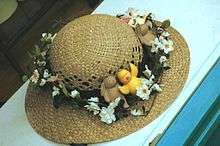Easter bonnet

An Easter bonnet is any new or fancy hat worn as a Christian headcovering on Easter, by tradition.[1] It represents the tail-end of a tradition of wearing new clothes at Easter,[2] in harmony with the renewal of the year and the promise of spiritual renewal and redemption.
The "Easter bonnet" was fixed in popular culture by Irving Berlin, whose frame of reference was the Easter parade in New York City, a festive walkabout that made its way down Fifth Avenue from St. Patrick's Cathedral:
In your Easter bonnet
with all the frills upon it,
You'll be the grandest lady in the Easter parade.[3]
At the depths of the Great Depression a new hat at Easter, or a refurbished old one, was a simple luxury.[4]
The broader English tradition of new clothes at Easter has been noticed in late 16th century references by Peter Opie,[5] who noted Mercutio's taunting of Benvolio in Romeo and Juliet: "Did'st thou not fall out with a Tailor for wearing his new Doublet before Easter?" At just the same time Thomas Lodge's moralising pamphlet Wits Miserie (London, 1596) recorded "The farmer that was contented in times past with his Russet Frocke & Mockado sleeues, now sels a Cow against Easter to buy him silken geere for his Credit".[6] In Samuel Pepys' diary, 30 March (Easter Day) 1662, he notes
Having my old black suit new furbished, I was pretty neat in clothes to-day, and my boy, his old suit new trimmed, very handsome.[7]
Poor Robin, an 18th-century English almanac maker, offered the doggerel
At Easter let your clothes be new
Or else be sure you will it rue.[8]
and the notion that ill-luck would dog the one who had not something new at Easter expanded in the 19th century.
Today the Easter bonnet is a type of hat that women and girls wear to Easter services, and (in the United States) in the Easter parade following it. Ladies purchased new and elaborate designs for particular church services, and in the case of Easter, taking the opportunity of the end of Lent to buy luxury items. Now, in a more casual society, Easter Bonnets are becoming harder to find,[9] as fewer and fewer women bother with the tradition.
Although the traditional Easter bonnet is a hat with depictions of Easter and spring with bunnies, flowers, eggs, etc., recently more creative designers have been producing full face hat and mask taking the Mantilla head dress from Spain as their inspiration. Some believe this does not reflect the traditional origins of the bonnet, but one cannot disagree that it is a bonnet of sorts that brings something new to the table, and so should be applauded.
Modern traditional Easter bonnets for children are usually white wide-brimmed hats with a pastel colored satin ribbon around it and tied in a bow. It may also have flowers or other springtime motifs on top, and may match a special dress picked out for the occasion.
Until recently, it was popular in infant school to ask a child to design an Easter-themed hat at that time of year. The aim was to get their parents to wear it to Easter services.
See also
References
- ↑ Katzenstein, Mary Fainsod (1999). Faithful and Fearless: Moving Feminist Protest Inside the Church and Military. Princeton University Press. p. 151. ISBN 9780691010083. Retrieved 31 May 2017.
- ↑ "Also significant of a new beginning are the new clothes often purchased for children for the Easter celebration. The practice many times was recalled from the mothers' own childhoods. New clothes are symbolic of renewal in general," observes Cindy Dell Clark, Flights of Fancy, Leaps of Faith: Children's Myths in Contemporary America (University of Chicago Press), 1998:97; also briefly noted in Iona Archibald Opie and Moira Tatem, eds. A Dictionary of Superstitions, (Oxford University Press) 1989, s.v. "Easter"; in Stephen Roud and Jennifer Westwood, The Penguin Guide to the Superstitions of Britain and Ireland, 2003, s.v. "clothes: new, blessing",
- ↑ Berlin, "Easter Parade", 1933.
- ↑ "The improved financial conditions of most post-Depression, post World War II families meant that new clothes were purchased year round, not just at Easter" (Marilyn Coleman, Lawrence H. Ganong, Kelly Warzinik, Family Life in 20th-Century America, 2007:127).
- ↑ Peter Opie, "Proposals for a Dictionary, Arranged on Historical Principles, of English Traditional Lore" Folklore 75.2 (Summer 1964:73-90) pp.77-80.
- ↑ Cited by Opie 1964:79.
- ↑ Opie 1964:79.
- ↑ Noted by Opie, op. cit. and repeated by folklorists as an old saw.
- ↑ "Where's the Easter wear? Forget the Easter eggs, try to find a bonnet", Boston Herald, April 16, 2006.
External links
- Spring meant ‘the Easter parade’ for fashionable set - Pantagraph (Bloomington, Illinois newspaper)